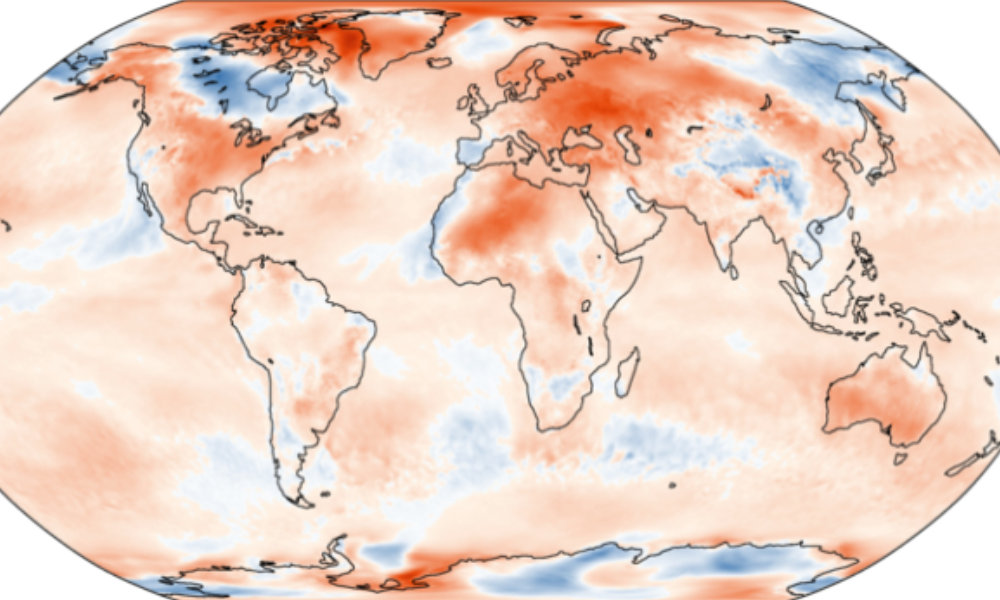World
March 2025 was 2nd-warmest on record globally, warmest ever in Europe

March 2025 was the second-warmest March on record globally and the warmest ever recorded in Europe, according to new data from the Copernicus Climate Change Service (C3S).
The global average surface air temperature for the month was 14.06°C (57.31°F), which is 1.6°C above the pre-industrial average for March, according to the C3S report released on Monday. This marks the 20th month in the last 21 months that global average temperatures have exceeded 1.5°C above pre-industrial levels — the key threshold outlined in the Paris Agreement.
The 12-month period from April 2024 to March 2025 was also the warmest such span on record, with an average temperature 1.59°C above pre-industrial levels and 0.71°C above the 1991–2020 average.
In Europe, March 2025 stood out as the warmest on record, with average land temperatures reaching 6.03°C — 2.41°C above the 1991–2020 average. The largest warm anomalies were observed in eastern Europe and southwest Russia, while colder-than-average temperatures were recorded across the Iberian Peninsula.
Globally, above-average temperatures were reported across the Arctic — particularly over the Canadian Archipelago and Baffin Bay — as well as the United States, Mexico, parts of Asia, and Australia. Cooler-than-average conditions were observed in parts of northern Canada, Hudson Bay, and eastern Russia, including the Kamchatka Peninsula.
Sea surface temperatures (SSTs) remained exceptionally high. The global average SST for March was 20.96°C (69.73°F), the second-highest on record for the month and just 0.12°C below the March 2024 record. Several regions, including the Mediterranean Sea and the northeast North Atlantic, experienced record-breaking sea surface warmth.
Arctic sea ice reached its lowest March extent in the 47-year satellite record, coming in at 6% below average. As March also marks the typical peak of Arctic sea ice, this represents the lowest annual maximum ever recorded.
Antarctic sea ice was 24% below average, marking its fourth-lowest March extent. Ice concentrations were especially low in the Barents Sea, Sea of Okhotsk, and most Antarctic ocean sectors, except the western Weddell Sea.
Rainfall patterns across Europe and beyond were marked by stark contrasts. Southern Europe, including the storm-hit Iberian Peninsula, saw wetter-than-average conditions, while central and eastern parts of the continent were unusually dry.
Globally, wetter-than-average conditions were reported in eastern Canada, the western U.S., the Middle East, and parts of Russia, Asia, and Africa. Meanwhile, large swaths of North America, Asia, Australia, and southern Africa experienced drier-than-average conditions.
“March 2025 was the warmest March for Europe, highlighting once again how temperatures are continuing to break records,” said Dr. Samantha Burgess, Strategic Lead for Climate at ECMWF.

-

 Health4 days ago
Health4 days agoFrance confirms 2 MERS coronavirus cases in returning travelers
-

 Health6 days ago
Health6 days ago8 kittens die of H5N1 bird flu in the Netherlands
-

 Entertainment4 days ago
Entertainment4 days agoJoey Valence & Brae criticize DHS over unauthorized use of their music
-

 Legal1 week ago
Legal1 week ago15 people shot, 4 killed, at birthday party in Stockton, California
-

 US News6 days ago
US News6 days agoFire breaks out at Raleigh Convention Center in North Carolina
-

 US News1 day ago
US News1 day agoMagnitude 7.0 earthquake strikes near Alaska–Canada border
-

 Health5 days ago
Health5 days agoEthiopia reports new case in Marburg virus outbreak
-

 Legal3 days ago
Legal3 days agoWoman detained after firing gun outside Los Angeles County Museum of Art




